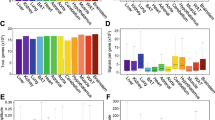Abstract
A circadian rhythm is a roughly 24-h cycle in biological processes and physiological phenomena such as sleep, feeding, and photosynthesis for many organisms on Earth. The circadian patterns are coordinated by rhythmical gene expression of clock genes. Time-course transcriptomic analyses involving statistical methods have shown coordination of periodic gene expression in many organisms. Here we applied the cosine fitting method COSOPT to identify novel oscillating genes in microarray data for the chordate Ciona intestinalis. This organism showed rhythmic oxygen consumption in our previous study, but there were few homologous clock genes showing rhythmic mRNA expression. To understand circadian behavior at the transcriptomic level, we analyzed the 817 of 21,938 probes showing a 23- to 25-h period by means of COSOPT. Coupling the analysis of period detection with functional annotations indicated that previously unknown rhythmic mRNA expression might exist in C. intestinalis. In addition, we are releasing our implementation of COSOPT by means of R and C. All source code and supplementary information are available from https://github.com/mhiromi/cosopt.


Similar content being viewed by others
References
Gallego M, Virshup D (2007) Post-translational modifications regulate the ticking of the circadian clock. Nat Rev Mol Cell Biol 8:139–148
Panda S, Antoch MP, Miller BH et al (2002) Coordinated transcription of key pathways in the mouse by the circadian clock. Cell 109:307–320
Ceriani MF, Hogenesch JB, Yanovsky M et al (2002) Genome-wide expression analysis in Drosophila reveals genes controlling circadian behavior. J Neurosci 22:9305–9319
Akhtar RA, Reddy AB, Maywood ES et al (2002) Circadian cycling of the mouse liver transcriptome, as revealed by cDNA microarray, is driven by the suprachiasmatic nucleus. Curr Biol 12:540–550
Dehal P, Satou Y, Campbell RK et al (2002) The draft genome of Ciona intestinalis: insights into chordate and vertebrate origins. Science 298(80):2157–2167
Rubin E, Shemesh Y, Cohen M et al (2006) Molecular and phylogenetic analyses reveal mammalian-like clockwork in the honey bee (Apis mellifera) and shed new light on the molecular evolution of the circadian clock. Genome Res 16:1352–1365
Imai KS, Hino K, Yagi K et al (2004) Gene expression profiles of transcription factors and signaling molecules in the ascidian embryo: towards a comprehensive understanding of gene networks. Development 131:4047–4058. doi:10.1242/dev.01270
Minamoto T, Hanai S, Kadota K et al (2010) Circadian clock in Ciona intestinalis revealed by microarray analysis and oxygen consumption. J Biochem 147:175–184
Straume M (2004) DNA microarray time series analysis : automated statistical assessment of circadian rhythms in gene expression patterning introduction. Methods Enzymol 383:149–166
Satou Y, Mineta K, Ogasawara M et al (2008) Improved genome assembly and evidence-based global gene model set for the chordate Ciona intestinalis: new insight into intron and operon populations. Genome Biol 9:R152
Gentleman RC, Carey VJ, Bates DM et al (2004) Bioconductor: open software development for computational biology and bioinformatics. Genome Biol 5:R80. doi:10.1186/gb-2004-5-10-r80
Oster H (2006) Transcriptional profiling in the adrenal gland reveals circadian regulation of hormone biosynthesis genes and nucleosome assembly genes. J Biol Rhythms 21:350–361
Tassy O, Dauga D, Daian F et al (2010) The ANISEED database: digital representation, formalization, and elucidation of a chordate developmental program. Genome Res 20:1459–1468. doi:10.1101/gr.108175.110
Erives A, Corbo JC, Levine M (1998) Lineage-specific regulation of the Ciona snail gene in the embryonic mesoderm and neuroectoderm. Dev Biol 225:213–225
Panda S, Hogenesch JB, Kay SA (2002) Circadian rhythms from flies to human. Nature 417:329–335. doi:10.1038/417329a
Pieper AA, Wu X, Han TW et al (2005) The neuronal PAS domain protein 3 transcription factor controls FGF-mediated adult hippocampal neurogenesis in mice. Proc Natl Acad Sci 102:14052–14057
Pickard BS, Christoforou A, Thomson PA et al (2008) Interacting haplotypes at the NPAS3 locus alter risk of schizophrenia and bipolar disorder. Mol Psychiatry. doi:10.1038/mp.2008.24
Sasakura Y, Mita K, Ogura Y, Horie T (2012) Ascidians as excellent chordate models for studying the development of the nervous system during embryogenesis and metamorphosis. Dev Growth Differ 54:420–437. doi:10.1111/j.1440-169X.2012.01343.x
Takimoto N, Kusakabe T, Tsuda M (2007) Origin of the vertebrate visual cycle. Photochem Photobiol 83:242–247. doi:10.1562/2006-06-30-IR-957
Boppana S, Scheglov A, Geffers R, Tarabykin V (2012) Cellular retinaldehyde-binding protein (CRALBP) is a direct downstream target of transcription factor Pax6. Biochim Biophys Acta Gen Subj. doi:10.1016/j.bbagen.2011.09.015
Glossop N, Gummadova J, Ghangrekar I, Hardin P, Coutts G (2014) Effects of TWIN-OF-EYELESS on clock gene expression and central-pacemaker neuron development in drosophila. J Biol Rhythms 29:151–166
Knowles A, Koh K, Wu J-T et al (2009) The COP9 signalosome is required for light-dependent timeless degradation and Drosophila clock resetting. J Neurosci 29:1152–1162. doi:10.1523/JNEUROSCI.0429-08.2009
Rajan KE, Rajkumar R, Liao C-C et al (2010) Light-induced COP9 signalosome expression in the Indian false vampire bat Megaderma lyra. J Physiol Sci 60:43–49. doi:10.1007/s12576-009-0064-4
Tsutsui H, Oka Y (2000) Light-sensitive voltage responses in the neurons of the cerebral ganglion of Ciona savignyi (Chordata: Ascidiacea). Biol Bull 198:26–28
Tsutsui H, Yamamoto N, Ito H, Oka Y (1998) GnRH-immunoreactive neuronal system in the presumptive ancestral chordate, Ciona intestinalis (Ascidian). Gen Comp Endocrinol 112:426–432
Kawada T, Aoyama M, Okada I et al (2009) A novel inhibitory gonadotropin-releasing hormone-related neuropeptide in the ascidian, Ciona intestinalis. Peptides 30:2200–2205
Shoguchi E, Hamada M, Fujie M, Satoh N (2011) Direct examination of chromosomal clustering of organ-specific genes in the chordate Ciona intestinalis. Genesis 49:662–672
Matsumae H, Hamada M, Fujie M et al (2013) A methodical microarray design enables surveying of expression of a broader range of genes in Ciona intestinalis. Gene 519:82–90. doi:10.1016/j.gene.2013.01.042
Author information
Authors and Affiliations
Corresponding author
Electronic supplementary material
Below is the link to the electronic supplementary material.
About this article
Cite this article
Matsumae, H., Ishiwata, R., Minamoto, T. et al. Detection of periodic patterns in microarray data reveals novel oscillating transcripts of biological rhythms in Ciona intestinalis . Artif Life Robotics 20, 347–352 (2015). https://doi.org/10.1007/s10015-015-0237-6
Received:
Accepted:
Published:
Issue Date:
DOI: https://doi.org/10.1007/s10015-015-0237-6




